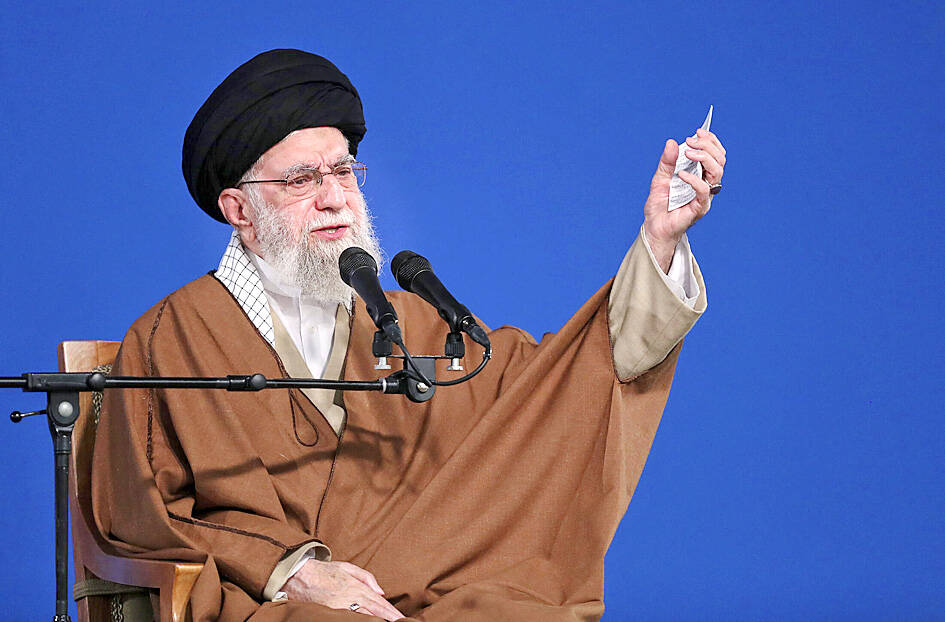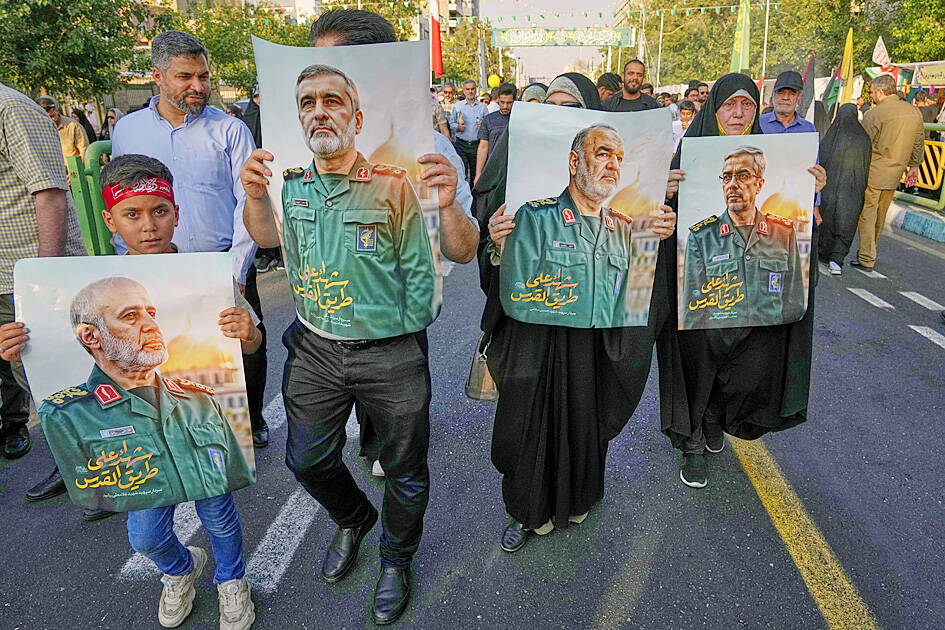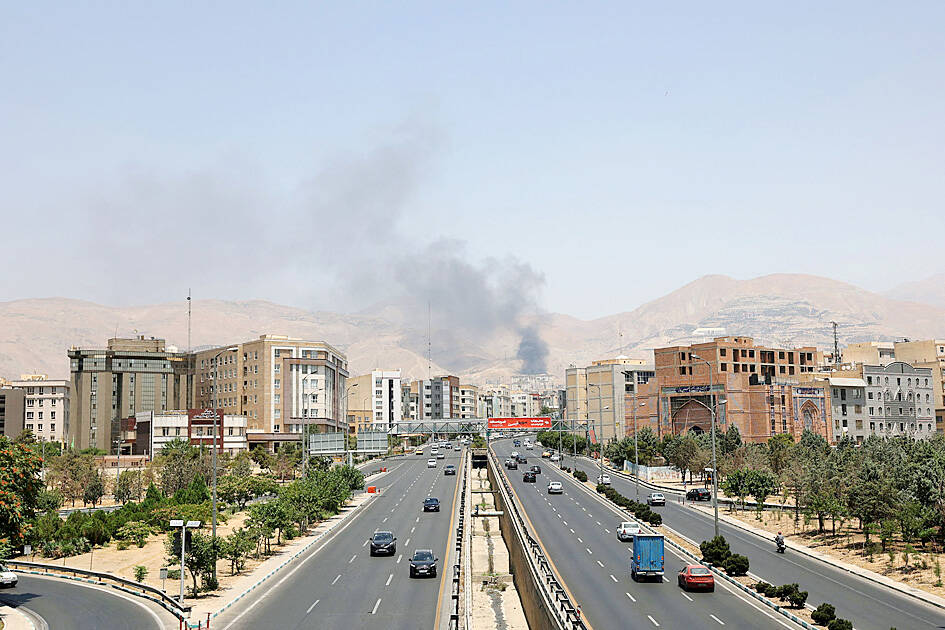Israel’s sweeping campaign of airstrikes aims to do more than destroy Iran’s nuclear centrifuges and missile capabilities. It seeks to shatter the foundations of Iranian supreme leader Ayatollah Ali Khamenei’s government and leave it near collapse, Israeli, Western and regional officials said.
Israeli Prime Minister Benjamin Netanyahu wants Iran weakened enough to be forced into fundamental concessions on permanently abandoning its nuclear enrichment, its ballistic missile program and its support for militant groups across the region, the sources said.
He also wants to leave Khamenei’s government debilitated. The campaign is about “exhausting the regime’s ability to project power and maintain internal cohesion,” one senior regional official said.

Photo: AP
Iran’s Islamic government faces an existential crisis unlike anything since the 1979 Revolution — not even the brutal 1980 to 1988 Iran-Iraq war posed such a direct threat to clerical rule. Israel, the Middle East’s most advanced military, can strike anywhere in Iran with drones and advanced F-35 fighter jets, assassinations by Mossad operatives, and cyberwarfare technology.
In recent days, Israel has broadened its targets to include government institutions such as the police and state television headquarters in Tehran. Netanyahu’s government is planning for at least two weeks of intense airstrikes, although the pace depends on how long it takes to eliminate Iran’s missile stockpiles and launch capacity, four government and diplomatic sources said.
Dennis Ross, a former Middle East envoy and advisor to several US administrations, said Iran is feeling the pressure and might be inching toward the negotiating table after the strikes eliminated much of Khamenei’s inner circle, damaged nuclear infrastructure and missile sites, and killed top security figures.

Photo: AP
Despite US President Donald Trump’s belligerent tone in recent days, he would likely accept if Tehran offered a credible path to a deal, Ross said.
However, after Tehran offered no concessions during six previous rounds of nuclear negotiations with the US, Washington would need firm assurances from Iran that its goals, including the permanent abandonment of enrichment, would be met before it would support a ceasefire, he said.
“I think the cost to them is going to be high,” he added.

Photo: Reuters
For Iran, there is one key calculation: letting the 86-year-old Khamenei retreat without humiliation, two Iranian sources said. Strip him of dignity or the prospect of survival, and he might choose all-out conflict, they added.
After Trump demanded Iran’s “unconditional surrender” on social media on Tuesday, Khamenei promised in a televised speech that any US military intervention in Iran would be met with “irreparable damage.”
In recent days, Netanyahu has also overtly raised the prospect of regime change, promising Iranians “the day of liberation is coming.”
However, with the Iranian opposition fragmented and no signs of divisions within the powerful Iranian Revolutionary Guard, which has nearly 250,000 fighters, including its Basij militia volunteers, there is scant prospect that Iran’s ruling elite would collapse easily.
There have been no major protests on the streets of Tehran, and many Iranians profess anger toward Israel for the attacks. Without a ground invasion or domestic uprising, regime change in Iran is a distant prospect, the officials said.
Mark Dubowitz, chief executive at the Foundation for Defense of Democracies think tank in Washington, said Trump ultimately wanted a diplomatic solution, but he was likely to allow Israel more time to pursue its military campaign to give the US more leverage at the negotiating table.
Dubowitz, an Iran expert who has been consulted by the Trump administration on its policy, said Israel’s main objective appears to be setting back Iran’s nuclear program as many years as possible. Central to that is removing its human capacity by killing nuclear and weapons scientists, Dubowitz said, adding that his team had identified 10 to 12 more who are likely being hunted by Israel.
Israel’s assassination of Hezbollah leader Hassan Nasrallah in September plunged the Lebanese group into disarray, but regional officials and observers warned that killing the ageing Khamenei would not have the same impact.
“Real power now resides with his son, Mojtaba, and the IRGC, which is deeply embedded despite the loss of key commanders,” one regional source said. “They remain the regime’s spine.”
Killing Khamenei, a religious leader to millions of Shiites, could cause a major backlash.
Jonathan Panikoff, a former deputy US national intelligence officer on the Middle East during Trump’s first term, said that if the Israeli campaign does foment regime change in Iran, it could result — at least initially — in a more hardline administration.
“What is likely to follow a theocratic Iranian government is not democracy but Islamic Revolutionary Guard Corps–istan,” said Panikoff, now at the Atlantic Council think-tank. “Israel might find itself in a perpetual, ongoing, and far more intense war that is no longer in the shadows.”
If the conflict does escalate, regional officials fear a collapse of Khamenei’s government would not lead to democracy, but to fragmentation — or worse: a civil war, fueled by Iran’s marginalized minorities — Arabs, Kurds, Azeris, Baha’is, Baluchis and Christians — could erupt in a dangerous power vacuum.
“And that, no one is ready for,” a Gulf source said.
Alex Vatanka, director of the Iran Program at the Middle East Institute, based in Washington, said that shockwaves from the collapse of the government in Tehran would not stop at Iran’s borders.
“A destabilized Iran could ignite unrest from Azerbaijan to Pakistan. Its collapse would reverberate across the region, destabilizing fragile states and reigniting dormant conflicts,” he said.

PARLIAMENT CHAOS: Police forcibly removed Brazilian Deputy Glauber Braga after he called the legislation part of a ‘coup offensive’ and occupied the speaker’s chair Brazil’s lower house of Congress early yesterday approved a bill that could slash former Brazilian president Jair Bolsonaro’s prison sentence for plotting a coup, after efforts by a lawmaker to disrupt the proceedings sparked chaos in parliament. Bolsonaro has been serving a 27-year term since last month after his conviction for a scheme to stop Brazilian President Luiz Inacio Lula da Silva from taking office after the 2022 election. Lawmakers had been discussing a bill that would significantly reduce sentences for several crimes, including attempting a coup d’etat — opening up the prospect that Bolsonaro, 70, could have his sentence cut to

A plan by Switzerland’s right-wing People’s Party to cap the population at 10 million has the backing of almost half the country, according to a poll before an expected vote next year. The party, which has long campaigned against immigration, argues that too-fast population growth is overwhelming housing, transport and public services. The level of support comes despite the government urging voters to reject it, warning that strict curbs would damage the economy and prosperity, as Swiss companies depend on foreign workers. The poll by newspaper group Tamedia/20 Minuten and released yesterday showed that 48 percent of the population plan to vote

A powerful magnitude 7.6 earthquake shook Japan’s northeast region late on Monday, prompting tsunami warnings and orders for residents to evacuate. A tsunami as high as three metres (10 feet) could hit Japan’s northeastern coast after an earthquake with an estimated magnitude of 7.6 occurred offshore at 11:15 p.m. (1415 GMT), the Japan Meteorological Agency (JMA) said. Tsunami warnings were issued for the prefectures of Hokkaido, Aomori and Iwate, and a tsunami of 40cm had been observed at Aomori’s Mutsu Ogawara and Hokkaido’s Urakawa ports before midnight, JMA said. The epicentre of the quake was 80 km (50 miles) off the coast of

Brazilian Senator Flavio Bolsonaro on Friday said that his father, jailed former Brazilian president Jair Bolsonaro, has chosen him to lead the country’s powerful conservative movement, shaking up next year’s election race. The 44-year-old senator said on social media that he will carry forward the political legacy that reshaped Brazilian politics. His announcement makes him an instant contender for the presidency. Jair Bolsonaro, 70, is unlikely to run after being sentenced to 27 years for plotting a coup and banned from public office. He is appealing and seeking a legislative pardon. The former president also faces serious health issues, including complications from a